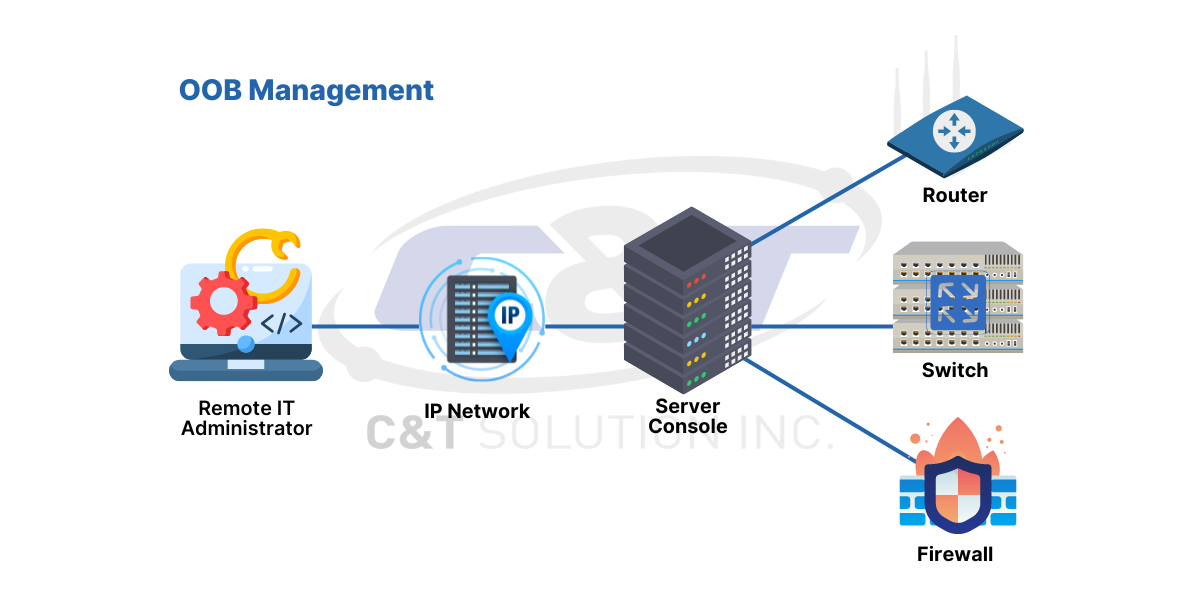What is OOB (Out-of-Band) Management?
What is OOB?
Out-of-band (OOB) management entails managing network operations and processes through an out-of-band network. This out-of-band network operates alongside the main (or in-band) network, yet it functions independently, not depending on the same infrastructure or services.

In-band Management vs Out-of-Band (OOB) Management
While In-Band Management allows for controlling a network through the local area network (LAN), Out-of-Band Management offers a secure, dedicated alternative way to access an IT network infrastructure. This method enables the administration of connected devices and IT assets independently from the corporate LAN.
Is Out-of-Band Management a software or hardware solution?
Management tools for software can monitor performance and assist in remote troubleshooting, but the devices need to be operational and connected to IT services via a functioning operating system to be manageable.
Serial consoles represent a unique scenario: they're essentially OOB since they don't rely on the primary network for remote management. Nonetheless, without specific hardware, these consoles are unable to modify UEFI (or BIOS) configurations, perform remote OS reinstalls, or resolve booting issues.
In contrast, hardware-based out-of-band management enables IT professionals to reach and control devices irrespective of their power state or whether the operating system (OS) is down or unresponsive.
Why do we need OOB Management?
The main advantage of out-of-band management is providing consistent access to crucial infrastructure when the main network fails. It serves as an essential backup, allowing teams to access vital infrastructure during network downtime and enabling prompt troubleshooting and repair to restore services quickly.
Benefits of OOB Management
With OOB, companies reduce costs related to recovery and decrease both the length and impact of downtime. Additional benefits include:
- Enhanced network performance: Handling intensive tasks on the out-of-band network improves main network speed and reliability.
- Minimized vulnerability: OOB management, crucial for an isolated management infrastructure (IMI), secures management interfaces from unauthorized access during breaches.
- Faster ransomware recovery: The OOB network facilitates a secure environment for efficient system restoration post-ransomware, reducing outage time and costs.
- Streamlined repairs: OOB allows deploying necessary tools for isolating, cleaning, and restoring services affected by failures or ransomware.
How OOB Management Improves Security
As OOB operates alongside the main (or in-band) network, it enhances security in several ways:
- Dedicated Firewall: OOB management has its own firewall, designed to monitor and control incoming and outgoing network traffic based on an applied set of security rules.
- Uninterrupted Remote Access: OOB management offers a backup route to essential remote systems, enabling teams to swiftly address configuration errors, hardware malfunctions, and cyber threats like ransomware, enhancing both time and cost efficiency in crisis resolution.
- Secured Management Network: Serving as a component of a separate management infrastructure (IMI), OOB management enhances security by concealing administrative interfaces from attackers who might compromise the main operational network.
- Enhanced Recovery from Ransomware: Through an OOB network, teams can establish a secure, isolated recovery environment (IRE), allowing them to use necessary applications and tools for restoration after ransomware incidents without the threat of further system contamination, thereby minimizing the impact and costs associated with ransomware-induced interruptions.
Industries that use OOB Management
- Telecommunications: For managing network infrastructure, including switches, routers, and other critical equipment, particularly in remote locations.
- Data Centers and Cloud Services: To ensure uptime and reliability, data centers use OOB management for server maintenance, troubleshooting, and disaster recovery.
- Banking and Financial Services: These institutions use OOB for secure and reliable network management to protect sensitive financial data and ensure continuous service.
- Healthcare: For managing and securing networks that support critical healthcare infrastructure and patient data, while ensuring regulatory compliance.
- Retail: Retailers use OOB management for point-of-sale systems and other critical infrastructure to maintain operations and secure customer data.
- Manufacturing and Industrial: To monitor and manage industrial control systems and machinery, especially in locations that may be remote or difficult to access.
- Energy and Utilities: For managing infrastructure critical to energy production and distribution, including remote monitoring and management of power grids.
- Government and Military: To ensure secure, remote management of networks and systems, often across dispersed geographical locations.
- Education: Universities and schools use OOB to manage and secure their network infrastructure, supporting administrative operations and e-learning platforms.
- Transportation and Logistics: For managing communications and logistics systems, including tracking and routing, especially in remote areas.
Why is OOB Management Important for Edge AI Devices?
Out-of-band (OOB) management is crucial for Edge AI devices due to their deployment in remote or hard-to-access locations and their involvement in critical processes. OOB management enables remote troubleshooting, updates, and maintenance, enhancing operational continuity and reducing downtime. It provides a secure, alternative channel for device management, which is vital for maintaining security, especially against cyber threats. Additionally, OOB management supports real-time monitoring and diagnostics, which are essential for the optimal performance of Edge AI tasks and facilitate energy management and scalability. This makes OOB management an indispensable tool for ensuring the reliability, security, and efficiency of Edge AI ecosystems.

